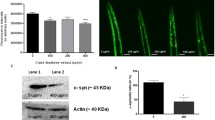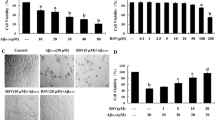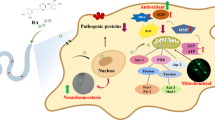Abstract
Purpose
Resveratrol is a polyphenol present in red wine for which the capability of directly interfering with the hallmark of Alzheimer’s disease (AD), i.e. toxic β-amyloid protein (Aβ) aggregation, has been shown recently. Since the stimulation of proteostasis could explain reduced Aβ-aggregation, we searched for proteostasis targets of resveratrol.
Methods
The transgenic Caenorhabditis elegans strain CL2006, expressing Aβ1–42 under control of a muscle-specific promoter and responding to Aβ-toxicity with paralysis, was used as a model. Target identification was accomplished through specific knockdowns of proteostasis genes by RNA interference. Effects of resveratrol on protein aggregation were identified using ProteoStat® Detection Reagent, and activation of proteasomal degradation by resveratrol was finally proven using a specific fluorogenic peptide substrate.
Results
Resveratrol at a concentration of 100 µM caused a 40 % decrease in paralysis. UBL-5 involved in unfolded protein response (UPR) in mitochondria proved to be necessary for the prevention of Aβ-toxicity by resveratrol. Also XBP-1, which represents an endoplasmic reticulum-resident factor involved in UPR, was identified to be necessary for the effects of resveratrol. Regarding protein degradation pathways, the inhibition of macroautophagy and chaperone-mediated autophagy prevented resveratrol from reducing paralysis as did the inhibition of proteasomal degradation. Finally, resveratrol reduced the amount of lysosomes, suggesting increased flux of proteins through the autophagy pathways and activated proteasomal degradation.
Conclusions
Resveratrol reduces the Aβ-induced toxicity in a C. elegans model of AD by targeting specific proteins involved in proteostasis and thereby reduces the amount of aggregated Aβ.




Similar content being viewed by others
References
Querfurth HW, LaFerla FM (2012) Alzheimer’s disease. N Engl J Med 362:329–344
Penke B, Tóth AM, Földi I, Szűcs M, Janáky T (2012) Intraneuronal β-amyloid and its interactions with proteins and subcellular organelles. Electrophoresis 33:3608–3616
Guerrero-Muñoz MJ, Castillo-Carranza DL, Kayed R (2014) Therapeutic approaches against common structural features of toxic oligomers shared by multiple amyloidogenic proteins. Biochem Pharmacol 88:468–478
Smid SD, Maag JL, Musgrave IF (2012) Dietary polyphenol-derived protection against neurotoxic β-amyloid protein: from molecular to clinical. Food Funct 3:1242–1250
Richard T, Pawlus AD, Iglésias ML, Pedrot E, Waffo-Teguo P, Mérillon JM, Monti JP (2011) Neuroprotective properties of resveratrol and derivatives. Ann N Y Acad Sci 1215:103–108
Link C (1995) Expression of human β-amyloid peptide in transgenic Caenorhabditis elegans. Proc Natl Acad Sci USA 92:9368–9372
Cohen E, Du D, Joyce D, Kapernick EA, Volovik Y, Kelly JW, Dillin A (2010) Temporal requirements of insulin/IGF-1 signaling for proteotoxicity protection. Aging Cell 9:126–134
Kim YE, Hipp MS, Bracher A, Hayer-Hartl M, Hartl FU (2013) Molecular chaperone functions in protein folding and proteostasis. Annu Rev Biochem 82:323–355
Tanaka K, Matsuda N (2014) Proteostasis and neurodegeneration: the roles of proteasomal degradation and autophagy. Biochim Biophys Acta 1843:197–204
Fitzenberger E, Deusing DJ, Marx C, Boll M, Lüersen K, Wenzel U (2014) The polyphenol quercetin protects the mev-1 mutant of Caenorhabditis elegans from glucose-induced reduction of survival under heat-stress depending on SIR-2.1, DAF-12, and proteasomal activity. Mol Nutr Food Res 58:984–994
Brenner S (1974) The genetics of Caenorhabditis elegans. Genet Dev 77:71–94
Stiernagle T (2006) Maintenance of C. elegans. WormBook. The online review of C. elegans biology. Caenorhabditis Genetics Center, University of Minnesota, Minneapolis, MN, USA, pp 1–11
Lehner B, Tischler J, Fraser AG (2006) RNAi screens in Caenorhabditis elegans in a 96-well liquid format and their application to the systematic identification of genetic interactions. Nat Protoc 1:1617–1620
Timmons L, Court DL, Fire A (2001) Ingestion of bacterially expressed dsRNAs can produce specific and potent genetic in Caenorhabditis elegans. Gene 263:103–112
Regitz C, Dußling LM, Wenzel U (2014) Amyloid-beta (Aβ1–42)-induced paralysis in Caenorhabditis elegans is inhibited by the polyphenol quercetin through activation of protein degradation pathways. Mol Nutr Food Res 58:1931–1940
Pfaffl MW (2001) A new mathematical model for relative quantification in real-time RT-PCR. Nucleic Acids Res 92:2002–2007
Link CD, Taft A, Kapulkin V, Duke K, Kim S, Fei Q, Wood DE, Sahagan BG (2003) Gene expression analysis in a transgenic Caenorhabditis elegans Alzheimer’s disease model. Neurobiol Aging 24:397–413
Pispa J, Palmén S, Holmberg CI, Jäntti J (2008) C. elegans dss-1 is functionally conserved and required for oogenesis and larval growth. BMC Dev Biol 8:51
Iwatsubo T, Odaka A, Suzuki N, Mizusawa H, Nukina N, Ihara Y (1994) Visualization of A beta 42(43) and A beta 40 in senile plaques with end-specific A beta monoclonals: evidence that an initially deposited species is A beta 42(43). Neuron 13:45–53
Jayasena T, Poljak A, Smythe G, Braidy N, Münch G, Sachdev P (2013) The role of polyphenols in the modulation of sirtuins and other pathways involved in Alzheimer’s disease. Ageing Res Rev 12:867–883
Rebolledo DL, Aldunate R, Kohn R, Neira I, Minniti AN, Inestrosa NC (2011) Copper reduces Aβ oligomeric species and ameliorates neuromuscular synaptic defects in a C. elegans model of inclusion body myositis. J Neurosci 31:10149–10158
Nath S, Agholme L, Kurudenkandy FR, Granseth B, Marcusson J, Hallbeck M (2012) Spreading of neurodegenerative pathology via neuron-to-neuron transmission of β-amyloid. J Neurosci 32:8767–8777
Regitz C, Wenzel U (2014) Amyloid-beta (Aβ1–42)-induced paralysis in Caenorhabditis elegans is reduced by restricted cholesterol supply. Neurosci Lett 576:93–96
Queen BL, Tollefsbol TO (2010) Polyphenols and aging. Curr Aging Sci 3:34–42
Mandel S, Amit T, Reznichenko L et al (2006) Green tea catechins as brain-permeable, natural iron chelators-antioxidants for the treatment of neurodegenerative disorders. Mol Nutr Food Res 50:229–233
Andres-Lacueva C, Shukitt-Hale B, Galli RL et al (2005) Anthocyanins in aged blueberry-fed rats are found centrally and may enhance memory. Nutr Neurosci 8:111–112
Amiot MJ, Romier B, Dao TM, Fanciullino R, Ciccolini J, Burcelin R, Pechere L, Emond C, Savouret JF, Seree E (2013) Optimization of trans-Resveratrol bioavailability for human therapy. Biochimie 95:1233–1238
Brown VA, Patel KR, Viskaduraki M, Crowell JA, Perloff M, Booth TD, Vasilinin G, Sen A, Schinas AM, Piccirilli G, Brown K, Steward WP, Gescher AJ, Brenner DE (2010) Repeat dose study of the cancer chemopreventive agent resveratrol in healthy volunteers: safety, pharmacokinetics, and effect on the insulin-like growth factor axis. Cancer Res 70:9003–9011
Hartwig K, Heidler T, Moch J, Daniel H, Wenzel U (2009) Feeding a ROS-generator to Caenorhabditis elegans leads to increased expression of small heat shock protein HSP-16.2 and hormesis. Genes Nutr 4:59–67
Lindblom TH, Dodd AK (2006) Xenobiotic detoxification in the nematode Caenorhabditis elegans. J Exp Zool A Comp Exp Biol 305:720–730
Broadley SA, Hartl FU (2008) Mitochondrial stress signaling: a pathway unfolds. Trends Cell Biol 18:1–4
Urano F, Calfon M, Yoneda T, Yun C, Kiraly M, Clark SG, Ron D (2002) A survival pathway for Caenorhabditis elegans with a blocked unfolded protein response. J Cell Biol 158:639–646
Liu RQ, Zhou QH, Ji SR, Zhou Q, Feng D, Wu Y, Sui SF (2010) Membrane localization of beta-amyloid 1-42 in lysosomes: a possible mechanism for lysosome labilization. J Biol Chem 285:19986–19996
Conflict of interest
On behalf of all authors, the corresponding author states that there is no conflict of interest.
Author information
Authors and Affiliations
Corresponding author
Rights and permissions
About this article
Cite this article
Regitz, C., Fitzenberger, E., Mahn, F.L. et al. Resveratrol reduces amyloid-beta (Aβ1–42)-induced paralysis through targeting proteostasis in an Alzheimer model of Caenorhabditis elegans . Eur J Nutr 55, 741–747 (2016). https://doi.org/10.1007/s00394-015-0894-1
Received:
Accepted:
Published:
Issue Date:
DOI: https://doi.org/10.1007/s00394-015-0894-1




